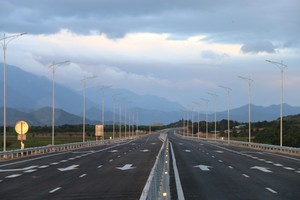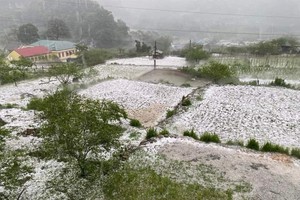Standing on the observatory in the heart of an immense indigo forest, the director of Tram Chim National Park in Dong Thap Province watches dozens of red-headed sarus cranes hovering over the grassy areas. Mr. Huynh The Phien looks pleased, as well he might be. “With the fresh green eleocharis grass and the much improved habitat, Tram Chim has become home to many sarus cranes,” he says with pride.

Three 5,000-hectare sections of the park dubbed A1, A4 and A5 support an increasing number of the cranes these days.
Every morning there are at least 50 sarus cranes feeding and performing their ritualistic dance in A1. On average, they are 1.6 meters tall, have a wingspan of 2.4 meters, and weigh around seven kilograms.
According to Tram Chim’s research department, 86 sarus cranes have been observed in the park at the beginning of the wet season.
“It’s a good sign proclaiming that the park’s natural environment is better. Until 1980, more than 800 sarus cranes would wend their way to Tram Chim every year, but after the forest fires, deforestation and the invasion of the mai duong tree (Mimosa pigra), a great number of them failed to return”, said Dr Tran Triet, head of the Ho Chi Minh City University of Natural Sciences’ Department of Human Ecology and Flora, who has been studying the sarus crane for several years.
In recent times Tram Chim National Park has been working with the International Sarus Crane Association and various scientists to improve the park’s environment, particularly the large eleocharis areas, and regulate water in the park to attract the valuable and rare bird.
“Many Vietnamese and foreigners have taken to visiting Tram Chim to see the sarus cranes”, said Mr. Le Thanh Tam, who runs the park’s Environmental Education and Ecotourism Center.
To promote Tram Chim’s potential, the park’s board of management is looking for entrepreneurial types to build roads, piers and a parking lot.

“If we want to foster the sarus cranes and boost their numbers, we should improve the areas of eleocharis grass, the birds’ main food, and thwart the advance of the mai duong tree,” Dr Tran Triet said.
“The Global Environmental Fund has just given us US$50,000 to control the entry of exotic plants and mobilize the locals to eradicate the mai duong tree,” Mr. Phien said.
The management board has appealed to the people who live around Tram Chim to do their best to protect the nature reserve.
Unfortunately, a lack of funds has halted scientific research and specific projects to protect the forest.
Tram Chim National Park contains 7,600 hectares of wetlands with a diversity of surface and semi-submerged plants, along with surface and riverbed animals.
However, birds are its main feature. More than 200 resident and migratory species have been identified, the most famous being the rare red-headed cranes that migrate between Viet Nam and Cambodia as the water levels vary.
























